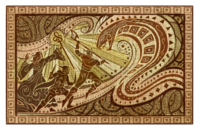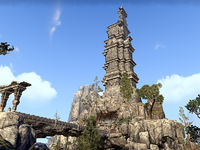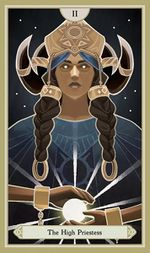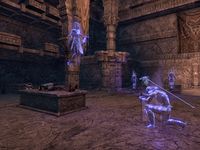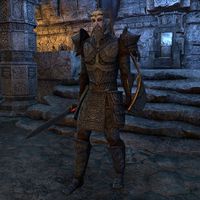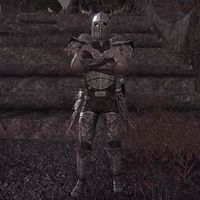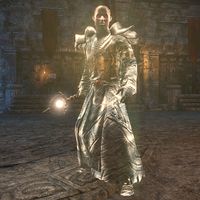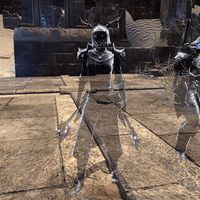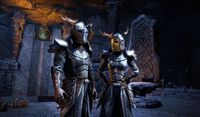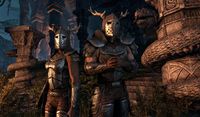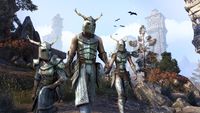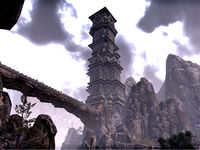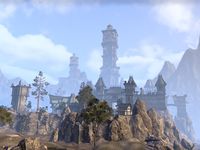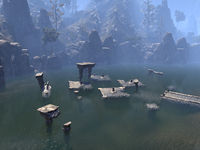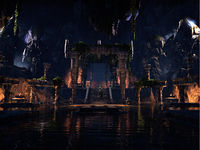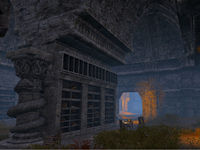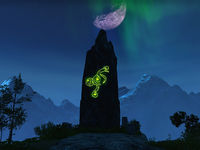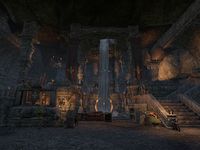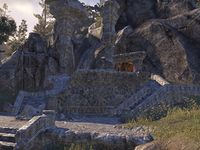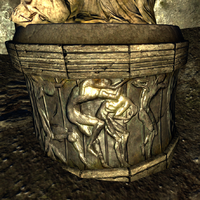Lore:Nede
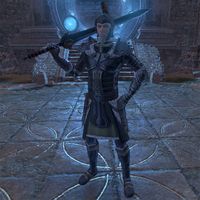
- "...human settlers occupied nearly every corner of Tamriel before Skyrim was even founded. These so-called "Nedic peoples" include the proto-Cyrodilians, the ancestors of the Bretons, the aboriginals of Hammerfell, and perhaps a now-vanished Human population of Morrowind. " —Frontier, Conquest
The Nedes (also known as the Nedic peoples or rarely Nedelings)[1][2][3] were a human race (or a group of races) of unknown extraction, who inhabited much of Tamriel during the Merethic and First Eras. The Duraki society of the Nedes who lived in Hammerfell (then called the "Deathlands")[4][5] largely followed the Cult of the Stars which revolved around the worship and study of the constellations, and beings known as the Celestials. Nedic culture experienced a sharp decline over several centuries as they began to assimilate into other cultures, before being completely exterminated by the Yokudan invasion of Hammerfell.[6][7][8][9]
History[edit]
Origins[edit]
The origin of the Nedic people is hotly debated. There are two major theories: one claiming the Nedes are native to Tamriel, and another claiming they migrated to Tamriel from Atmora:
| Native to Tamriel | "Out of Atmora"[UOL 1] |
|---|---|
| According to Nordic myth, men were first formed on Throat of the World when the sky breathed onto the land, hence why the Songs of the Return partially refer to the Nords' return to what they believe was their original homeland.[10][11] Supporters of this theory argue that all mortal life started on Tamriel, and that the Septim Empire sought to historically link themselves to the Nords to gain their support by leaving out any mention of the existence of humans in Tamriel before the coming of Ysgramor.[UOL 1][UOL 2]
An argument made partially in favor for the nativity theory is Gwylim Press' own "Frontier, Conquest, and Accomodation",[UOL 2][UOL 3] which acknowledges Atmoran settlers in Tamriel before Ysgramor, but establishes one particular Nedic group as aboriginal to Tamriel. Those Nedes were a minority in elven lands and as such had to accommodate themselves with them.[12] Likewise, the Altmeri variation of "The Monomyth" states Men were present on Tamriel after Convention to carry away Lorkhan's Body.[13] This theory is supported by various traces of Nedic cultures on Tamriel which can be dated to before Ysgramor arrived in the late Merethic Era. Some Kothringi artifacts can be traced back to the early Merethic Era or possibly even the Dawn Era[14][15] - over a millennium before the arrival of Ysgramor. According to the Reachfolk, human tribes dwelled within the caves of the Druadach Mountains long before the conquests of Mer and Nords in the Karth region,[16] where their ancestors fled to shortly after Lorkhan's sundering.[17] |
The Out of Atmora theory states that pre-Ysgramor Atmorans emigrated from different parts of Atmora in many waves and at different times,[18] and after arriving in what is now Skyrim they soon began to spread throughout much of northern Tamriel - resulting in what are now referred to as the Nedic peoples,[19] having occupied nearly every corner of the continent before Skyrim was even founded. While their beginnings are murky, the Nedes are broadly considered to have come to Tamriel from elsewhere,[UOL 4] and the earliest known traces of human presence in Tamriel have been dated to the mid-Merethic Era between circa ME 1000 and ME 800.[12]
The term 'Nedic Tribes' actually covers a wide panoply of different human cultures from different parts of Atmora, with a variety of traditions and practices. For the Nedes, Tamriel became a great mixing cauldron—some Atmoran practices were retained, but many were lost.[20] Critics of this theory claim that it is based on Imperial propaganda of a shared "Nordic Fatherland". Some suspect the theory was pushed by the Septim Empire's revisionism to legitimize the General of Atmoran descent, by claiming a traditionally Nedic throne by retrofitting Skyrim's early history.[UOL 5] Nevertheless, scrying into the past has yielded evidence that Atmorans and Nedes were considered one and the same in their time,[12] lending Dunmeri support to the idea of an Atmoran origin for both.[21] |
The Deathlands of Volenfell and the Beastfolk[edit]
—Sample from a Nedic prayer[6]
While Nedes inhabited several of the modern provinces, it was in the sun-baked wastelands of Hammerfell which they knew as the Deathlands that Nedic civilization truly thrived. The Duraki Nedes faced numerous foreign invasions, including both the Ayleids and the Dwemer, who dismissed the Duraki as backward savages to justify subjugating them. These Nedes also frequently clashed with their neighbors, the primitive stone-worshipping Iron Orcs,[7][22] although there is evidence of harmonic periods between the two peoples.[23] Nedic texts often reference an event called the "Autumn of Snakes", where according to the histories hundreds of mammoth-sized snakes emerged from the ground and devoured whole towns before finally being subdued by the Nede spear-maiden, Ranev the Coal-Eyed Wanderer. Nedic scholars describe the Autumn in meticulous and near-identical detail, though that the event is now known as completely apocryphal.[24]
Despite these frequent conflicts, Duraki culture prospered for centuries in the Deathlands. The Nedes were known to be skilled in masonry, with their bustling cities constructed largely from stone. However, little of this stonework remains, as what wasn't completely destroyed by the invading Ra Gada was often appropriated and modified beyond recognition.[25] While the Duraki were known to be devout star worshippers, during the Yokudan invasion their prayers went unanswered, and many looked to other sources for salvation. This did them little good and the Nedes quickly fell to the Yokudan horde, vanishing from the Deathlands forever.[7]
Nedic settlement within provinces inhabited by Beast races is known to have occurred but is not well-documented. During the Merethic Era, a Nedic fort was known to have been only a short distance from a Dune adeptorium in the province of Elsweyr.[26] Many early human tribes are known to have once inhabited Black Marsh, among them being the Horwalli, Kothringi, Orma, and Yespest,[27] though they are never referred to as Nedes and survived well into at least the Second Era. The Kothringi are said to be descended from the Nedic humans, and lived in Black Marsh as far back as records go.[28]
Under the Elves[edit]
In many lands the Nedes existed as a minority, and had no choice but to co-exist relatively peacefully alongside elves, oftentimes in a subordinate position. There are records of self-serving Nedic knights going as far back as the Merethic Era, such as Sir Cadwell, the hero of Cyrod and champion of the Third Nedic Massacre who was once a member of Khunzar-ri's Kra'jun.[29]
The proto-Bretons[UOL 6][30] were the Nedes who settled in High Rock. They are known by the retroactive nomenclature, the Druids of Galen,[31][32] a moniker later adopted by their Breton descendants.[33] Guided by a line of druidic kings, these Nedes survived in ancient High Rock by tapping into, nurturing, and terraforming nature.[34][35] If Man or Mer came to High Rock first is debated in scholarly circles. Some believe that Nedic civilization and their Druid King were already established in the province when the Aldmer arrived,[31] while others claim that the Nedes arrived in High Rock afterwards, and encountered the elves gradually with a variety of reactions and outcomes.[12][36][UOL 4] The Direnni established a feudal hierarchy where the Nedes lived at the bottom, while the elven nobles positioned on top. The Nedes of High Rock may have also clashed with the orcs in that region.[23] The Direnni enjoyed many privileges over their human subjects including the 'Perquisite of Coition', the right to engage in recreational intercourse with any Nede of their choice.[37]
Many Direnni took advantage of this and took on Nedic concubines, which often resulted in the birth of mixed-race "manmer" offspring who would become the Bretons. While the Bretons were not officially recognized as members of the noble houses they descended from, they often occupied social positions above those of the Nedic peasantry. Eventually this arrangement was formalized with the creation of a new caste between the Elves and the Nedes, in which the Bretons enjoyed a comfortable position in society, but were forbidden from marrying Elves in an attempt to preserve the Elven race. Eventually after generations of interbreeding with their Nedic underlings the Bretons were completely assimilated, birthing a new culture with those of the most elven blood on top. Even during the Direnni Hegemony, they ruled largely through human clients, who later became the Breton nobility.[UOL 4]
While relations between the Nedes and the Direnni were cordial if rather unbalanced, the Nedes suffered greatly under the tyranny of the Daedra-worshipping Ayleids. The Ayleids would commonly stage raids on Nedic lands, enslaving those whom they captured.[7] Once in Ayleid lands the Nedes were held in bondage alongside members of various other human races, forced to work in a variety of menial jobs, such as agriculture and maintaining infrastructure. In Ayleid kingdoms under the grip of more malevolent Daedric princes, human slaves were subjected to horrific cruelties.[38][1][39]
In the Middle Merethic Era, the Nedes, subjugated by the Ayleids, began to resist with help from a mysterious figure, Shezarr. Nedic folklore often depicts Shezarr as a teacher and unifier rather than a warrior. Duraki legend credits him with teaching stoneworking and command over nirncrux while the Perena claim he introduced soul magic. In Cyrod, Shezarr supposedly revealed Ayleid battle-magic secrets to humans. A stone tablet from Sedor depicts him as "the Shezzarine, Shor-Who-Lives, Teacher of Men." These tales speak of Shezarr as a source of inspiration to the Nedic resistance against Ayleid oppression, sustaining their spirit until Saint Alessia's rebellion.[40]
In the year 1E 242, the Slave Queen Alessia led a rebellion against the Ayleid slave masters, resulting in the emancipation of all slaves within the Ayleidic empire. While the slaves were freed, centuries of Ayleidic suppression and intermingling with other enslaved groups had taken their toll on Nedic culture in Cyrodiil and all that remained were their mixed race descendants, the Imperials.[38][1][39]
Nedic presence within Valenwood is unknown, though the Bosmer have been recorded in early history as "soiling Time's line" by taking Mannish wives.[13]
The Nedes also maintained a presence in Skyrim, but little is known of their relations with the native Falmer or the Atmorans who replaced them. The Nedes of Skyrim were believed to be a more primitive people than their cousins in other lands, however their skill in metallurgy was known to be quite advanced.[41] They were generally nomads but still had some form of a religious congregation (worshipping Arkay instead of the Atmoran Orkey).[42] The Nedic peoples of the late Merethic era hunted the lion population of a western valley in The Rift for its furs.[43]
The Nedes spread across northern Tamriel, and once had a presence in Morrowind during the Merethic,[12][44] with tribes that marched and plundered across the land.[45] It is recorded in Dunmeri texts that these Nedes waged at least one bloody war against the ancient Chimer in the early First Era, the Rontha being the largest of the tribes to invade Stonefalls. causing mass death and destruction and refusing diplomatic resolutions with the Chimer. After a few short years they controlled most of the modern-day Stonefalls and cut off reinforcements from the north, before being stopped by the so-called Brothers of Strife, but at a terrible cost for the Chimer.[46][45] These Nedes were accomplished leatherworkers, attributed to their nomadic nature.[47]
Disappearance and Legacy[edit]
—Fragment from a Nede's journal[48]
Over the centuries, various events contributed to the dwindling of Tamriel's Nedic population. They had suffered a history of defeat and enslavement at the hands of various peoples including Dwemer, Ayleids, Yokudans, and Direnni. Cyro-Nords captured Nedic ports along the Strident Coast (a somewhat unknown region presumably around the Gold Coast of Cyrodiil and the southern coastline of Hammerfell).[49] In the west, The Nedes who inhabited the isle of Herne had long struggled against the elves prior to the Ra Gada, and though they fought a courageous battle under their Warchief Haakon, they fell before the Yokudan onslaught.[50] Everywhere, Indigenous populations were left broken and scattered, absorbing the cultures of conquering people, or migrating to be subsumed in new lands.[7] By the ninth century of the First Era, Nedic culture was confined to the deserts of Volenfell.
In Cyrod, early Imperial culture had formed during the time of the Alessian Empire, reflected in relics containing a mix of Ayleid and early Imperial influences.[51] Inhabitants of Colovia had begun using present-day Imperial names, even while Nedes in nearby Hammerfell maintained their strong cultural presence.[52] In the year 1E 808[53] the "warrior wave" of the Yokudans, the Ra Gada, made landfall in Tamriel. They quickly swarmed the province, killing or enslaving all that they crossed. Soon they had displaced the Nedes everywhere but in the remote region of Craglorn. There, Nedes embittered by the decline of their culture began to turn to sources of spiritual guidance other than the stars.[6][48] This did them little good when the Anka-Ra, one particularly brutal and conquest-hungry band of Ra Gada led by the sadistic Emperor Tarish-Zi, reached Craglorn and dispatched the Nedes as quickly as they had elsewhere. After years of struggle and decline, Nedic culture had finally met its end.
Though the Nedes no longer exist as a distinct people, much of their culture survives in the societies of their descendants. Even in Hammerfell much of the Nedic religion, custom, and language was adopted by their annihilators, the Redguards.[54] In Nibenay the great old Nedic traditions were maintained, remaining as one of the people true to the original Nedic culture. The Nibenese people are said to be the closest thing to a pure-bred Nede still remaining on Tamriel.[20] Ownership of Nedic possessions (particularly those with inscriptions) came with great prestige.[55]
Tribes[edit]
The Nedic tribes were far from homogeneous. Each tribe came with its own culture, and their cultures were further mixed and admixed after arrival in Tamriel. Some were as different from each other as Reachman and Redguard.[18][20] Though they are said to have come from Atmora, Nords are sometimes considered Nede as well.[12]
The catch-all term "Nede" is applied so broadly to Merethic-Era humans as to be almost worthless.[18] The term "Nedic Tribes" actually covers a wide panoply of different human cultures of disputed origin, with a variety of traditions and practices.[20] Tribes were led by kings and warchiefs, ruling different parts of the Nedic realm, and were known to meet in councils with other Nedic rulers.[56] They were markedly divergent in appearance, such as those in High Rock mixing with elves to the point of resembling them and the Kothringi of Black Marsh developing silver-colored skin. The known names given to groups of Merethic Era humans are as follows, with their status as solely being Nedes considered to be very general:
- In Black Marsh:
- The Kothringi are said to be descended from the Nedic humans, and lived in Black Marsh as far back as records go.[28] The Empire speculated that they may have been sent there as refugees or prisoners, or settled along the coastal waterways and adapted to the environment.[27] As tribes of Men such as Kothringi, Horwalli, Orma, and Yespest survived well into the modern age, they are not considered Nedes, and are likely descendants of Nedes in the same way Imperials are.[27][57]
- In Cyrodiil:
- The Al-Gemha, Al-Hared, Men-of-ket, and Kothri were among the men herded as slaves by the Ayleids from across all the Niben in Cyrod.[38]
- The Men-of-ge were among the men herded as slaves from across the Niben by the Ayleids, who were eventually "destroyed" when the Flower King Nilichi made great sacrifice to a long-forgotten insect god.[38]
- The Perena were a Nedic tribe found in Cyrodiil[18][58] and Hammerfell.[59] They practiced the observation of the stars in the night sky, according to ancient texts such as the Perenaal Fragment.[56] Three members of the Perena sect called the Eternal Watchers were responsible for locking away Virmaril the Betrayer.[59]
- The Thousand-Strong of Sedor were an ancient tribe of men of Sedor. They were enslaved by Ayleids and later liberated by Pelinal Whitestrake.[1]
- In Hammerfell:
- The Duraki were a tribe that resided in Craglorn and had their seat of power at Skyreach.[56][58][60] Their warriors followed the ancient Nedic High King Durac against the invading Anka-Ra, but met their downfall after Virmaril the Betrayer slew the council of nedic kings and the tribe fell to the Yokudan onslaught.[61][62]
- The Keptu or Ket Keptu were a tribe who settled in central Hammerfell[63] and the Jerall Mountains bordering Cyrodiil.[18][64] They are inconsistently described as being Nedes[58] and separate from Nedes,[1] likely a repercussion of the usage of "Nede" as a catch-all term and oversight of their differences from the Perena.[18][38] The Reachman Dreadhorn Clan are descendants of the Keptu.[65]
- In Northern Tamriel (High Rock, Morrowind, Skyrim):
- The proto-Bretons, the Nedic ancestors of the modern Bretons, inhabited High Rock.[31][33][32][66]
- The Men-of-kreath were imported from the north (presumably Falkreath) by the Ayleids as slave labor.[38] King Kestic, who ruled a Nedic tribe from a forested region near Skyreach,[60][61] may have been a king of the Men-of-kreath.
- The Rontha were a nomadic, particularly vicious clan among those who invaded the Stonefalls region of Morrowind. They were known for branding both people and items captured in battle.[47]
Notable Nedes[edit]
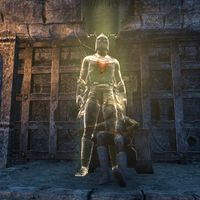
- Alessia the Slave Queen — the first Dragonborn Empress of the First Empire.
- Cadwell the Betrayer — one of the Companions of the Merethic Era Khajiit hero Khunzar-ri who assisted in the imprisonment of Kaalgrontiid
- High King Durac — leader of the council of nine Nedic kings (The Blood, Flame, Forest, Frost, Shadow, Spirit, Storm, Sun kings) and last High King of the Nedes.
- Warchief Haakon — The leader of the clan inhabiting Herne, whom later exterminated by the Ra Gada.
- Huna — The lover of Pelinal Whitestrake and one of the warriors of the Alessian Slave Rebellion.
- Kestic, The Forest King — the king of the northern forests, betrothed to Saradin, the daughter of High King Durac.
- Lamae Beolfag (better known as Lamae Bal) — a priestess of Arkay who was transformed into the first vampire.[67]
- Nunex Faleria — lord and member of the regency council that oversaw the Kingdom of Kvatch circa 1E 361.
- Warchief Ornskar — The leader of the Rontha invasion force battling with the Chimer in Stonefalls.
- Ranev the Coal-Eyed Wanderer — a mythical heroine that lived in the mountains in Craglorn. She is known for her triumphant victory in the Autumn of Snakes and her pilgrimage on the Gray Passage, where she earned the name, "the Favored of the Stars".
- Teo Bravillius Tasus — An Alessian centurion and the namesake of Bravil, built atop the ruins of an Ayleid city he captured.[68]
Notes[edit]
- The Song of Pelinal mentions "Zuathas the Clever-Cutting Man", a Nedic healer with a keptu name who treated Morihaus when he was wounded.
Gallery[edit]
See Also[edit]
- Nede Names
- For a list of notable Nedes, see here.
- For game-specific information, see the ESO article.
Books[edit]
- Before the Ages of Man by Aicantar of Shimerene — Chronicles the major events of the Dawn and Merethic Eras
- Blasius' Unfinished Manuscript by Blasius — Notes denouncing Yokudan brutality and Emperor Tarish-Zi
- The Brothers of Strife by Nili Omavel — On the ancient conflict between Nedes and Dunmer
- Defaced Nedic Prayer Book — A collection of Nedic prayers surrounding the Guardian constellations
- Fragments from a Nedic poem, title unknown — An ancient poem surrounding the Celestial guardians
- Frontier, Conquest by the University of Gwylim Press, 3E 344 — Details the presence of humans in Tamriel before the original Nordic conquests thought to bring humans to Tamriel
- Journal of Culanwe by Culanwe — The journal of a priestess of Azura surrounding a peace treaty between the Nedes and the Ayleids
- Mysteries of the Mundus Stones by Lady Cinnabar of Taneth — Lady Cinnabar's theories on magicka
- Nedes of the Deathlands by Argus Mender — A research paper surrounding the possible presence of Nedic civilizations in Hammerfell
- Nedic Dueling Swords by Merethic Society — A plaque describing two ancient dueling swords
- Nirncrux: A Study by Mendan Flot,
Regent of Roiling Concoctions — A treatise on a primordial element discovered in Craglorn - Pocket Guide to the Empire, 1st Edition: Hammerfell by the Imperial Geographical Society
- Pocket Guide to the Empire, 3rd Edition: All the Eras of Man, A Comprehensive History of our History by the Imperial Geographical Society
- Saradin's Diary by Saradin — An ancient Nedic account of forbidden love
- Skyreach Explorer by Reginus Buca, Historian, University of Gwylim — Scholarly journals on the exploration of Skyreach
- Virmaril's Journal by Virmaril, Advisor to High King Durac — A disgruntled mage's plot to betray his liege
- Watcher Shavmar's Journal by Watcher Shavmar — The journal of an ancient Nedic guardian
- Waterlogged Journal — An old journal detailing Tarish-Zi's attack on a city
- Tales of Abba Arl: The Fat Mother by Abba Arl — A children's tale of Orsa — Folklore about nedic deity "Fat Mother"
- Tales of Abba Arl: The Ox's Tale by Abba Arl — A children's tale surrounding the Ox, one of the four parents — Folklore about the relevance of oxen in nedic society
- Targa's Note by Targa — A farewell letter from a soldier under the command of Tarish-Zi
References[edit]
- ^ a b c d e The Song of Pelinal
- ^ Aurbic Enigma 4: The Elden Tree — Beredalmo the Signifier
- ^ The Unveiled Azadiyeh Answers Your Questions — The Unveiled Azadiyeh
- ^ Waterlogged Journal
- ^ Blasius' Unfinished Manuscript — Blasius
- ^ a b c Defaced Nedic Prayer Book
- ^ a b c d e Nedes of the Deathlands — Argus Mender
- ^ Fragments from a Nedic poem, title unknown
- ^ Mysteries of the Mundus Stones — Lady Cinnabar of Taneth
- ^ Children of the Sky
- ^ Pocket Guide to the Empire, 1st Edition: Skyrim — Imperial Geographical Society, 2E 864
- ^ a b c d e f Frontier, Conquest — University of Gwylim Press, 3E 344
- ^ a b The Monomyth
- ^ Silver Wish Medallion antiquity codex entries by Verita Numida and Gabrielle Benele in ESO
- ^ Nest of Shadows antiquity codex entry by Ugron gro-Thumog in ESO
- ^ Lost Valley Redoubt's loading screen in ESO
- ^ Nchuand-Zel's loading screen in ESO
- ^ a b c d e f Lady Clarisse Laurent Answers Your Questions — Lady Clarisse Laurent and Stibbons
- ^ Pocket Guide to the Empire, 3rd Edition: All the Eras of Man, A Comprehensive History of our History — Imperial Geographical Society, 3E 432
- ^ a b c d Chancellor Abnur Tharn Answers Your Questions — Chancellor Abnur Tharn
- ^ Sorcerer Vunal in Window on the Past
- ^ Orcs of Tamriel, Volume 3 — Grassius Vilco
- ^ a b Nedic Hex Totem antiquity codex entry by Verita Numida and Ugron gro-Thumog in ESO
- ^ The Ubiquitous Sinking Isle — Lailfin, Steward of Histories at the Illumination Academy
- ^ Castles and Coffers Volume III: Hel Ra Citadel
- ^ Khunzar-ri: Tales, One — Aneshi, Keeper of Legends for the 16 Kingdoms
- ^ a b c Pocket Guide to the Empire, 3rd Edition: The War with the Trees: Argonia and the Black Marsh — Imperial Geographical Society, 3E 432
- ^ a b Lodyna Arethi's dialogue during King of Dust in ESO
- ^ Cadwell the Betrayer's dialogue in ESO
- ^ Loremaster's Archive - The Druid Circles of Galen — Laurel of the Stonelore
- ^ a b c Modern Day Bretons: Man or Mer? — Vastyr Historian Filibert Beauchamp
- ^ a b Race Description of Breton in TES:Arena
- ^ a b Loremaster's Archive - Tamriel's Dungeons — Dhulef
- ^ Wyrd and Druid — Archdruid Barnabe's Discourse with Mainlanders, 2E 553
- ^ Loremaster's Archive - Bretons & High Isle — Lady Arabelle
- ^ Pocket Guide to the Empire, 3rd Edition: The Sons and Daughter of the Direnni West: High Rock — Imperial Geographical Society, 3E 432
- ^ The Bretons: Mongrels or Paragons? — Phrastus of Elinhir
- ^ a b c d e f The Adabal-a — Morihaus
- ^ a b Pocket Guide to the Empire, 3rd Edition: The Seat of Sundered Kings: Cyrodiil — Imperial Geographical Society, 3E 432
- ^ The Footsteps of Shezarr — Sister Priscia Stolvo
- ^ Nedic Dueling Swords — Merethic Society
- ^ Lamae Bal's dialogue and flashbacks in Scion of the Blood Matron
- ^ Into the Lion's Den
- ^ Window on the Past quest
- ^ a b Dialogue with Sorcerer Vunal
- ^ The Brothers of Strife — Nili Omavel
- ^ a b Nedic Wineskin in ESO
- ^ a b Waterlogged Journal
- ^ Pocket Guide to the Empire, 1st Edition: Cyrodiil — Imperial Geographical Society, 2E 864
- ^ Dialogue with Throne Keeper Farvad
- ^ First Era Cross-Cultural Relic description
- ^ Titus Valerius' dialogue in ESO
- ^ Holidays of the Iliac Bay — Theth-i
- ^ Pocket Guide to the Empire, 1st Edition: Hammerfell — Imperial Geographical Society, 2E 864
- ^ Letter to Skull-Brother Xandier — Emutaril
- ^ a b c Skyreach Explorer — Reginus Buca, Historian, University of Gwylim
- ^ 2920, The Last Year of the First Era — Carlovac Townway
- ^ a b c Nedic Duraki, Keptu, and Perena Armor costume and showcase descriptions
- ^ a b Watcher's Ritual Stole antiquity codex entry by Verita Numida in ESO
- ^ a b Saradin's Diary — Saradin
- ^ a b Virmaril's Journal — Virmaril, Advisor to High King Durac
- ^ Watcher Shavmar's Journal — Watcher Shavmar
- ^ Crafting Motif 12: Barbaric Style — Seif-ij Hidja
- ^ Nicolard's Notes on Ruin Origins — Nicolard Lia
- ^ Meet the Character - Domihaus the Bloody-Horned — Gherig Bullblood
- ^ Wyrd and Druid — Archdruid Barnabe's Discourse with Mainlanders, 2E 553
- ^ Opusculus Lamae Bal ta Mezzamortie — Mabei Aywenil, Scribe
- ^ Daughter of the Niben — Sathyr Longleat
Note: The following references are considered to be unofficial sources. They are included to round off this article and may not be authoritative or conclusive.
- ^ a b Kurt Kuhlmann's Posts - On the origin of Nedes, The Imperial Library
- ^ a b Michael Kirkbride's posts - On the Nedes (04/12/99), The Imperial Library
- ^ Michael Kirkbride's undated posts - From Totemic Traditions in Atmoran Culture, The Imperial Library
- ^ a b c Lawrence Schick and Phrastus on Altmer Culture
- ^ Michael Kirkbride's posts - On the First Era, and the Empire of Skyrim (04/12/99), The Imperial Library
- ^ Leamon Tuttle's Posts - 04/24/2022
|
|||||||||||||||||||||||||||||||||||||||||||
